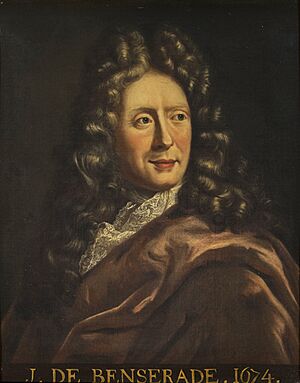Isaac de Benserade facts for kids
Quick facts for kids
Isaac de Benserade
|
|
|---|---|
 |
|
| Born | 5 November 1613 Lyons-la-Forêt, Kingdom of France |
| Died | 10 October 1691 (aged 77) |
| Language | French |
| Nationality | French |
| Literary movement | Précieuses |
| Notable awards | Académie française |
Isaac de Benserade (baptized 5 November 1613 – 10 October 1691) was a famous French poet and writer. He was especially known for writing plays and for creating the words for court ballets. These ballets were grand dance shows performed for kings and queens.
Contents
Early Life and Royal Connections
Isaac de Benserade was born in Lyons-la-Forêt, a town in Normandy, France. His family had connections with a very powerful person at the time, Cardinal Richelieu. Richelieu was a chief minister to King Louis XIII. He even gave Benserade a yearly payment of 600 livres, which was a good amount of money back then.
After Cardinal Richelieu passed away, Benserade lost his payment. However, he became very popular at the royal court. He was especially liked by Anne of Austria, who was the Queen of France.
His Plays and Ballets
Benserade started writing plays when he was quite young. His first tragedy, Cleopatra, was written in 1636 when he was 23. He wrote it for a famous actress named Mademoiselle Bellerose. His first comedy was called Iphis and Iante. It was first performed in 1634 at the Hôtel de Bourgogne, a well-known theater in Paris.
He became very important for writing the words for many court ballets. These ballets were popular entertainment at the French court. In 1674, Benserade was chosen to join the French Academy. This was a very important group of writers and scholars in France. He had a lot of influence there.
In 1675, he wrote poems to go with 39 special statues. These statues showed scenes from Aesop's fables and were part of a maze at the Palace of Versailles.
Famous Literary Debates
One of Benserade's most famous works was his sonnet (a type of poem) about the biblical figure Job. He wrote it in 1651. This poem caused a big debate in the court. People argued if Benserade's Job sonnet was better than another famous poem called Urania by Voiture.
This argument divided the court and many clever people into two groups. One group supported Benserade and was called the Jobelins. The other group supported Voiture and was called the Uranists. Important people like the prince de Conti and Mademoiselle de Scudéry were on Benserade's side.
Later Life
A few years before he passed away, Benserade moved to a quiet place called Gentilly. There, he spent his time working on a translation of the Psalms, which are religious songs or poems. He almost finished this big project.
Works
- 1636 Cléopâtre
- 1637 La Mort d’Achille et la Dispute de ses armes
- 1637 Gustaphe ou l’Heureuse Ambition
- 1637 Iphis et Iante
- 1640 Méléagre
- 1648 Le Sonnet de Job
- 1651 Ballet de Cassandre
- 1651 Ballet des Fêtes de Bacchus
- 1653 Ballet de la Nuit
- 1654 Ballet des Proverbes
- 1654 Ballet des Noces de Pélée et de Thétis
- 1654 Ballet du Temps
- 1655 Ballet des Plaisirs
- 1655 Grand Ballet des Bienvenus
- 1656 Ballet de Psyché
- 1657 Ballet de l’Amour malade
- 1658 Ballet royal d’Alcidiane
- 1659 Ballet de la Raillerie
- 1661 Ballet royal de l’Impatience
- 1661 Ballet des Saisons
- 1663 Ballet des Arts
- 1664 Ballet des Amours déguisés
- 1664 Les Plaisirs de l'île enchantée
- 1665 Ballet royal de la Naissance de Vénus
- 1666 Ballet des Muses
- 1669 Ballet royal de Flore
- 1676 Métamorphoses d’Ovide en rondeaux
- 1678 Fables d'Ésope en quatrains
- 1681 Ballet du Triomphe de l’Amour
- 1682 Labyrinte de Versailles
- Stances
See also
 In Spanish: Isaac de Benserade para niños
In Spanish: Isaac de Benserade para niños

